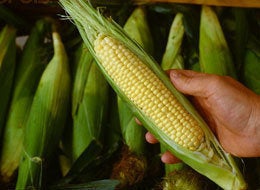
Mexico's decision to start growing genetically modified (GM) corn is sowing nothing but trouble.
After the government lifted a nation-wide ban against transgenic maize last March, peasants in northern Chihuahua have threatened to burn plots of Monsanto and DuPont patented crops if necessary. On October 18, the Mexican chapter of Greenpeace draped black banners reading "Transgenics: End of Independence" over a monument in the nation's capitol. And a group of 700 scientists and intellectuals have signed an open letter to President Calderon, demanding that the administration take drastic measures to protect Mexico's 60-odd native varieties from crossing with transgenic breeds.
"It's a lie," biologist Elena Alvarez-Bullya told me bluntly, when I asked her whether the government's plan to begin experimenting with GM corn might give farmers a badly needed boost in production levels.
"Using non-transgenics and hybrid seeds would be enough to produce double of what Mexico needs," she added. "We don't need transgenics to be self-sufficient."
The problem is Mexico is anything but self-sufficient right now. The country imported 9.5 million tons of corn last year, most of it intended for animal feed. According to one pro-biotechnology group, the government's decision to lift a ten-year ban on GM crops could mean an additional 5 million tons of corn each year, if the experimental plots are approved for commercial cultivation by 2012.
However, as environmentalist Silvia Ribeiro pointed out to me, if Mexico now imports 89 percent of the corn it needs for animal feed (almost all of it from the U.S.) demand is coming from a burgeoning transnational pork and chicken industry, not from Mexican consumers.
"It's not Mexico that needs more maize," Ribeiro scoffed. "It's Tyson's chickens."
But you can't blame Mexico for being nervous, especially after a corn deficit in 2007 made prices for tortilla flour shoot up by 400 percent. Thousands of furious protesters rioted in the streets of the capitol, waving corn cobs in their hands. With more food shortages expected in the near future thanks to a hodgepodge of reasons, including competition with biofuels as well as rising temperatures, Calderon's government has decided it's more practical to see GM crops as a possible Superman rather than a Frankenstein monster.
Still, it's unclear whether "Frankencorn" can deliver on its promises. Critics point to a recent study by the Union for Concerned Scientists which found that genetic engineering just plain doesn't mean more crops. While the U.S. has boosted soy and corn production in the past 13 years, the study maintains, that has more to do with better breeding techniques and other conventional methods rather than biotechnology.
If genetic engineering failed to boost crop yields in the U.S., both Ribiero and Alvarez-Buylla asked me, what kind of magically different outcome could be expected in Mexico?
On one hand, the GM genie is already out of the bottle. Traces of transgenes were discovered in Mexican corn fields back in 2001, even though the nation's ban against GMO imports was still in place. Scientists like Alvarez-Buylla (who has studied the issue closely) agree the contamination probably happened as a result of the U.S. dumping the market with cheap corn, which farmers may have unknowingly planted.
And, as corn pollen is known to travel as far as six miles by wind, Mexico's one-of-a-kind varieties are seen as highly vulnerable to even more genetic mixing. The agriculture ministry has promised that the 120,000 square meters set aside for GM experiments will be isolated from other farms, and are located in states where corn is scarce.
Such promises have done little to soothe worries that genetic engineering is out of control.
"Let's say they conduct these experiments in highly controlled conditions - they do whatever necessary to make sure no insects go in and no pollen goes out," Ribeiro said to me. "How's that supposed to be replicated in the field? You can experiment all you want in confined conditions, but as soon as you take these transgenics into the countryside, no way are farmers going to use the same techniques."
Observers are also uneasy that the government has only offered vague explanations about how it will protect Mexico's native breeds. So far, nobody knows where exactly the GM corn will be cultivated, leading Greenpeace organizer Aleira Lara to observe, "watching the Mexican government trying to confront these issues is like watching a giant snowball--it keeps piling on one irregularity after another."
Personally, I feel like I'm not watching snow as much as I'm watching Mexico play with fire.
"This technology has failed," Lara told me. "The Mexican government has taken a totally irresponsible decision that puts the country's environment and biodiversity in danger. We're putting one of the world's most basic grains at risk. And that has implications for the whole world."